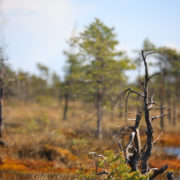VALUE CO-CREATION FOR THE JYVÄSKYLÄ FOREST PROGRAMME 2030
The CORE project has undertaken a case study of the production of Jyväskylä’s strategy for the use of its forest, the Jyväskylä Forest Programme. The city of Jyväskylä has utilised a collaborative approach to produce this strategy. The collaborative process involved public administrators from three different sub-units of the city administration and non-public sector actors such as NGOs and companies.
The city involved an external facilitator to guide the process, which took a total of 1,5 years from start to finish. The aim of the process was to get different actors together to discuss the issue of use of forest in Jyväskylä and finally based on these discussions arrive to a collective decision about how to use the forest. The collaborative project ended May 2018.
Our task as researchers of the value co-creation team of the CORE project was to see what value this process created for the participants in their collaboration and if the final co-created outcome was valuable for them. Value co-creation, as a concept from marketing, has its origins in the understanding that customers are co-creating the value of a product or a service provided to them by the way the product or service is utilised.
In this particular case, value is not co-created by the customer or the provider, in the traditional sense, but by different stakeholders of a particular issue, the use of forest.
While previous literature has looked at value in the connection of a product or a service, our case looks at value co-creation around the issue of use of forest around Jyväskylä city.
The values of forest sought by different stakeholders vary. As Pearce and Moran (1994)point out, there is a variety of ways to understand the value of a forest. There can be use-value (both direct and indirect), future value (future direct or non-direct value), and non-use-value (bequest or existence value). While forest use-value for e.g. bird-watchers and mushroom or berry pickers increases when the flora and fauna in a forest are flourishing, the use-value for the forest-harvesters grows with the possibility to efficiently harvest trees that are of the right size and quality.
Those that use the forest for upkeeping their condition, or doing sports, may have even have contradicting requests from a more cleared forest and well taken care of pathways, to more wild nature like and less intervention. Also the aesthetic value of the forest plays a role, for those using it for their walks. While these different values are pursued by different stakeholders, sometimes stakeholders themselves need to deal with conflicting demands from their different roles.
The process of value co-creation, including interaction and integration (Gummesson & Mele, 2010; Pera, Occhiocupo, & Clarke, 2016), is successful when stakeholders are able to find ways to increase the value and minimise the loss of value for the different stakeholders and the whole group. The collaborative project of Jyväskylä Forest Program produced a wealth of results.
Most of the participants of the collaborative effort thought that the process itself was heavy and time consuming. However, they also thought the result and outcome of the co-creation process was very good.
That is to say; the process of value co-creation was not as appreciated as the final outcome of the process. The outcome of the process was taken into the consideration when the city officially decided what to do with the forest.
From this case we can learn that from the point of view of value co-creation even if the process is not as satisfactory it is worth of its pains to get a solution that pleases all the parties involved. Despite the seemingly conflicting value premises of use of forest, the solution can be found in a collaborative and facilitated process and even if the process itself is not as much valued the final outcome is.
Sanne Bor and Pia Polsa
References
Gummesson, E., & Mele, C. (2010). Marketing as Value Co-creation Through Network Interaction and Resource Integration. Journal of Business Market Management, 4, 181–198.
Pearce, D. W., & Moran, D. (1994). The economic value of biodiversity. Earthscan.
Pera, R., Occhiocupo, N., & Clarke, J. (2016). Motives and resources for value co-creation in a multi-stakeholder ecosystem: A managerial perspective. Journal of Business Research, 69, 4033–4041.
Sanne Bor works as Researcher at Hanken School of Economics, on the CORE project, and at LUT University, on the PackageHeroes project. She studies collaboration among organizations, among others from the view of value co-creation, partial organization and accountability.
Pia Polsa works as Associate Professor in Marketing at Hanken School of Economics and leads the CORE project’s value co-creation work package. Her current research interests are value creation in environmental conflicts, poverty alleviation, and marketing in non-profit settings like health care in developing countries.





Leave a Reply
Want to join the discussion?Feel free to contribute!